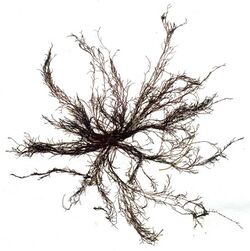Biology:Polysiphonia stricta
From HandWiki
Revision as of 04:09, 10 August 2022 by imported>Wincert (update)
Short description: Species of alga
| Polysiphonia stricta | |
|---|---|

| |
| Scientific classification Error creating thumbnail: Unable to save thumbnail to destination
| |
| (unranked): | Archaeplastida |
| Division: | Rhodophyta |
| Class: | Florideophyceae |
| Order: | Ceramiales |
| Family: | Rhodomelaceae |
| Genus: | Polysiphonia |
| Species: | P. stricta
|
| Binomial name | |
| Polysiphonia stricta (Dillwyn) Greville
| |
| Synonyms[1] | |
| |
Polysiphonia stricta is a small red marine alga in the Division Rhodophyta.
Polysiphonia stricta forms dense clumps of branching axes. The plants grow to 25 cm high.[2]
Description
P. stricta grows as small tufts of much branched tufts, growing to no more than 25 cm high.[2] The axes are erect, ecorticate, with 4 periaxial cells growing from prostrate axes. All 4 of the periaxial cells are of the same length.[2][3]
Reproduction
Spermatangial branchlets are formed in clusters at the apices. Cystocarps are on wide stalks and are urceolate. The tetraspores are in series in the final branches.[2]
Habitat
Epizoic and epiphytic in the low littoral to 20 m.[2]
Distribution
Found around the British Isles, the West Atlantic and American Atlantic.[2]
References
- ↑ M.D. Guiry in Guiry, M.D. & Guiry, G.M. 2018. AlgaeBase. World-wide electronic publication, National University of Ireland, Galway. http://www.algaebase.org/search/species/detail/?species_id=E4e1d55668c427064 ; searched on 19 August 2018.
- ↑ 2.0 2.1 2.2 2.3 2.4 2.5 Seaweeds of the British Isles Volume 1 Rhodophyta Part 3A Ceramiales. The Natural History Museum, London. ISBN:0-11-310045-0
- ↑ Bunker, F.StP. D.,Brodie, J.A., Maggs, C.A. & Bunker, A.R. 2017. Seaweeds of Britain and Ireland. Second Edition. Wild Nature Press, Plymouth, UK. ISBN:978-0-9955673-3-7
Wikidata ☰ Q3395813 entry
 |

